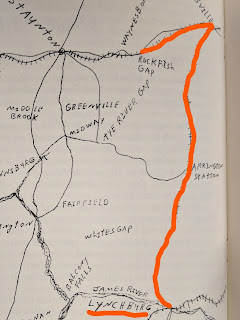 |
| Across from Geddes Mountain Road along US-29 (Amherst Highway) northbound (Photo credit: Steven Akiyama) |
So apparently there was action at
the Tye River.
First question: where is the Tye
River?
The Tye River runs through western Virginia, and feeds into the
James River around Norwood, Virginia. Officially known as a tributary, it's
among the many streams/rivers/tributaries in Virginia.
So then what happened at the Tye
River?
A Civil War skirmish! That's what
happened!
Throughout this story, I'll be
referring to these books, in addition to my web sources:
- Gallagher, Gary W., ed. The Shenandoah Valley Campaign of 1864. Chapel Hill: University of North Carolina Press, 2006.
- Bowery, Charles R., Jr. The Richmond-Petersburg Campaign, 1864-65. Santa Barbara, CA: Praeger, 2014.
- Walker, Gary C. Hunter's Fiery Raid Through Virginia Valleys. Roanoke, VA: A&W Enterprise, 1989.
This sign is near what was a key bridge in and out of Lynchburg, Virginia. Lynchburg, when the Civil War began, was a key transportation hub for the South. The city linked the Shenandoah Valley, Richmond, Virginian port cities, and DC, via the Orange & Alexandria (O&A) Railroad and the Virginia-Tennessee Railroad. This linkage moved goods and food around the South; when the Civil War began, these railroads allowed troops and supplies to move very quickly for the various military campaigns (remember, it was an 8-hour railroad trip from Richmond to DC, versus a 3-day carriage ride).
 |
| A map of Lynchburg and the surrounding railroads, 1864 (Source) |
By 1864, the pivotal Battle of
Gettysburg has occurred, and President Lincoln began preparing the Union for a
"hard war:" destruction of civilian property and seizing what they
could for army purposes (Gallagher, p. 201). Ulysses S. Grant was promoted to
general-in-chief of the Union Army in March 1864, and established a plan to
close in on Richmond, the Confederate capital (Bowery, Jr., p. 2). The
Shenandoah Valley Campaign was a critical part of the strategy to take
Richmond. Major General David Hunter and later Major
General Philip H. Sheridan, were charged with securing the Shenandoah Valley.
Meanwhile, General Lee, leading the Army of Northern Virginia, was focused on
holding defenses around Richmond and Petersburg.
 |
| C.S.A. Major General John C. Breckinridge (Source) |
As part of Lynchburg's defenses, the
Botetourt Battery was under the command of Major General John C. Breckinridge.
On June 10, 1864, Breckinridge ordered the Botetourt Battery join him in
Rockfish Gap via train. En route north from Lynchburg, Capt. Henry Douthat and
his Battery encountered Union forces trying to sabotage the O&A Railroad
(Walker, p. 182-183). Though Capt. Douthat wanted to push on, he knew the
importance of this particular stretch of railroad. At nightfall, Capt. Douthat
positioned his men defensively near a wooden bridge where the railroad crossed
the Tye River.
So why was this railroad, this bridge, so important?
 |
| Map of railroads in Virginia, 1859 (Source) |

Comments
Post a Comment